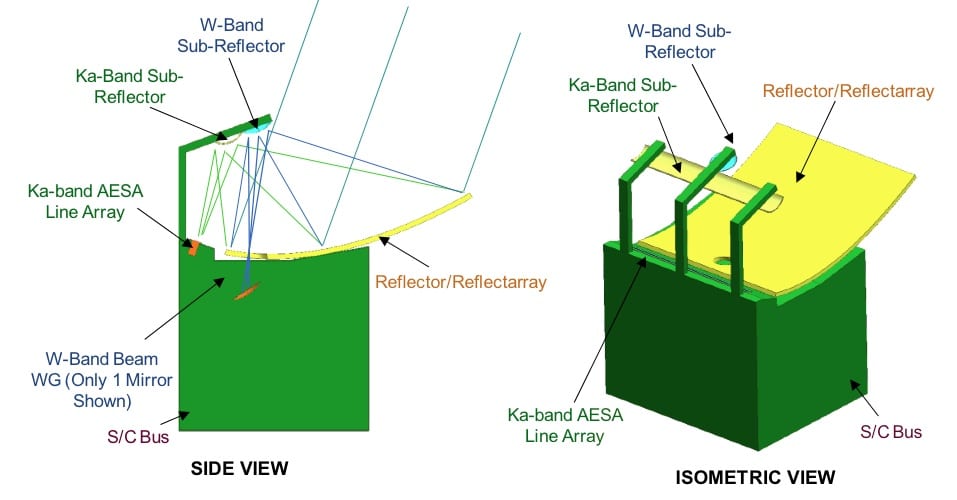 |
| A three-dimensional, detailed structure of Hurricane Sandy measured by the TRMM Precipitation Radar (PR) on Oct. 28, 2012 at 1725 UTC (1:25 PM EDT). Source: NASA. |
 |
| Candidate antenna architecture for ACE radar. Source: NASA. |
New Radar Technologies for the Aerosol/Cloud/Ecosystems Mission | Earthzine
NASA’s future Aerosol/Cloud/Ecosystems (ACE) Mission will address fundamental science questions concerning the role of aerosols on cloud development and ecosystems. Recommended by the National Research Council’s (NRC) Earth Science Decadal Survey,
ACE targets a broad class of hydrometeor types. The mission’s instruments will measure cloud droplets, ice crystals, rain and snow, which are subject to change in the presence of aerosols. These changes also impact the Earth’s ecosystems and the ocean’s storage of carbon dioxide. The ACE measurements aim to improve the understanding of aerosol, cloud and ecosystem interactions. Also, ACE measurements will have spin-off benefits, including aiding in air-quality forecasting.
ESTO :: ROSES2010 IIP (A.26) Selections
| Title | Antenna Technologies for 3D Imaging, Wide Swath Radar Supporting ACE |
| Full Name | Paul Racette |
| Institution Name | NASA Goddard Space Flight Center |
The Earth Science Decadal Survey calls for an Aerosol, Cloud and Ecosystems (ACE) mission for measurements to provide a better understanding of the role of aerosols on cloud development. The ACE Science Working Group recommends a dual-frequency radar comprised of
The NASA Goddard Space Flight Center (GSFC) and Northrop Grumman Corporation Electronic Systems (NGES) have developed an innovative approach, minimizing size and weight, with a shared aperture that builds upon ESTO’s investments into large-aperture reflectors and utilizes high-TRL radar architectures. We propose to advance the system technology readiness level of two key antenna system components:
Our proposed work and methodology entails a dual-frequency antenna comprised of a primary cylindrical reflector/reflectarray surface illuminated by a fixed W-band feed (compatible with a quasi-optical beam waveguide feed, such as that employed on CloudSat) and a Ka-band AESA line feed. The highly innovative reflectarray surface provides beam focusing at W-band, but is transparent at Ka-band. Over a three-year period of performance, we propose to design, build,environmentally test, and demonstrate a scale model of the dual-frequency antenna, culminating in a suborbital test flight demonstration using the GSFC Cloud Radar System and raising the reflector/reflectarray TRL from 3 to 6. Finally, we plan to advance the AESA feed design towards a space demonstration via development and testing of key GaN MMIC components,raising that TRL from 3 to 4+. | |
NASA's other ACE: Advanced Composition Explorer (ACE) Home Page
The Earth is constantly bombarded with high speed particles coming not only from the sun, but also from outside of the solar system. Studying these energetic particles can help us understand the origin and evolution of our solar system. The Advanced Composition Explorer (ACE) spacecraft carries nine instruments that can collect and measure these particles 10 to 1000 times better than previous spacecraft. From ACE, Scientists on Earth will receive information about the solar wind such its velocity, temperature, and composition.
ACE will orbit the sun very near the Earth (approximately 1/100 of the distance from the Earth to the sun). From here it will be able to determine which particles hit the Earth. This information will help scientists to better understand phenomena such as solar flares. Ace will also be able to warn us of encroaching geomagnetic storms that disrupt communications and are hazardous to astronauts.
xxx


No comments:
Post a Comment